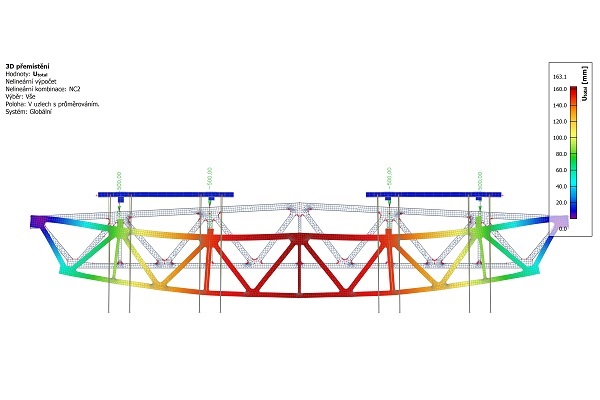1. Introduction to the course: Probability calculations in civil engineering, examples of selected calculations.
2. Introduction to probability theory and mathematical statistics: Basic concepts and principles of the theory of probability theory and mathematical statistics, random phenomenon, probability of random phenomenon, statistical moments.
3. Probabilistic expression of random variables: Random variable, nonparametric (empirical) probability distribution, histogram.
4. Monte Carlo method: Inclusion of the Monte Carlo method into a list of probability methods, Monte Carlo history, Buffon\'s needle, the first systematic use of the Monte Carlo method. Law of large numbers, generators (pseudo) of random numbers. Numerical integration with the Monte Carlo method. An illustrative example of elemental calculation using the Monte Carlo method.
5. Simulation Based Reliability Assessment (SBRA): Insertion of the SBRA method into the overview of probability methods, SBRA simulation method, probability computation by SBRA (random quantities, computational model, reliability function analysis), illustrative examples of probability calculations by SBRA.
6. Parametric probability distribution of a continuous random variable: Overview of important continuous probability distribution, Gaussian probability distribution, logarithmic-normal probability distribution, coefficient of determination.
7. Statistical dependence of input random variables: Correlation and correlation coefficient, correlation matrix. Double and triple histogram.
8. Stratified and Advanced Simulation Methods: Incorporating stratified and advanced simulation methods into a list of probability methods. Latin Hypercube Sampling - LHS, the principle of the method and its application. Method of Importance sampling.
9. Approximation methods: FORM and SORM methods. Response surface method.
10. Direct Optimized Probabilistic Computation - DOProC I.: Incorporation of the Direct Optimized Probability Computation Method into the overview of probability methods, substance of the method, basic computational algorithm, DOProC method application in ProbCalc programming system, demonstration of calculation.
11. Direct Optimized Probabilistic Computation - DOProC II.: Optimization techniques in DOProC method, theoretical principles of individual optimization techniques, examples of calculation using individual optimization procedures, recommended optimization techniques utilization in probability calculations by DOProC method.
12. Direct Optimized Probabilistic Computation - DOProC III.: Demonstrations of application software using the DOProC method.
13. Reliability and safety of building structures: Probabilistic approach to assessment of reliability and safety of building structures, calculation of probability of failure: load effect, resistance of the structure, computational model, reliability function, reliability index, target probability. Design working life of a structure.
14. Sample examples of selected probability tasks.
2. Introduction to probability theory and mathematical statistics: Basic concepts and principles of the theory of probability theory and mathematical statistics, random phenomenon, probability of random phenomenon, statistical moments.
3. Probabilistic expression of random variables: Random variable, nonparametric (empirical) probability distribution, histogram.
4. Monte Carlo method: Inclusion of the Monte Carlo method into a list of probability methods, Monte Carlo history, Buffon\'s needle, the first systematic use of the Monte Carlo method. Law of large numbers, generators (pseudo) of random numbers. Numerical integration with the Monte Carlo method. An illustrative example of elemental calculation using the Monte Carlo method.
5. Simulation Based Reliability Assessment (SBRA): Insertion of the SBRA method into the overview of probability methods, SBRA simulation method, probability computation by SBRA (random quantities, computational model, reliability function analysis), illustrative examples of probability calculations by SBRA.
6. Parametric probability distribution of a continuous random variable: Overview of important continuous probability distribution, Gaussian probability distribution, logarithmic-normal probability distribution, coefficient of determination.
7. Statistical dependence of input random variables: Correlation and correlation coefficient, correlation matrix. Double and triple histogram.
8. Stratified and Advanced Simulation Methods: Incorporating stratified and advanced simulation methods into a list of probability methods. Latin Hypercube Sampling - LHS, the principle of the method and its application. Method of Importance sampling.
9. Approximation methods: FORM and SORM methods. Response surface method.
10. Direct Optimized Probabilistic Computation - DOProC I.: Incorporation of the Direct Optimized Probability Computation Method into the overview of probability methods, substance of the method, basic computational algorithm, DOProC method application in ProbCalc programming system, demonstration of calculation.
11. Direct Optimized Probabilistic Computation - DOProC II.: Optimization techniques in DOProC method, theoretical principles of individual optimization techniques, examples of calculation using individual optimization procedures, recommended optimization techniques utilization in probability calculations by DOProC method.
12. Direct Optimized Probabilistic Computation - DOProC III.: Demonstrations of application software using the DOProC method.
13. Reliability and safety of building structures: Probabilistic approach to assessment of reliability and safety of building structures, calculation of probability of failure: load effect, resistance of the structure, computational model, reliability function, reliability index, target probability. Design working life of a structure.
14. Sample examples of selected probability tasks.
